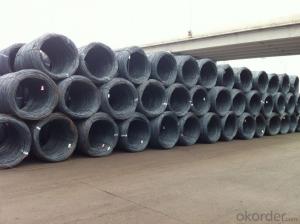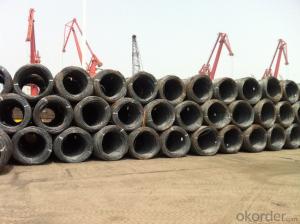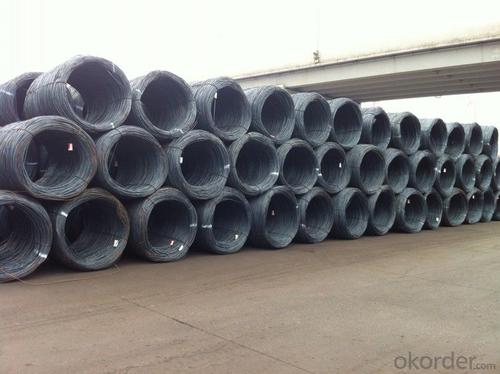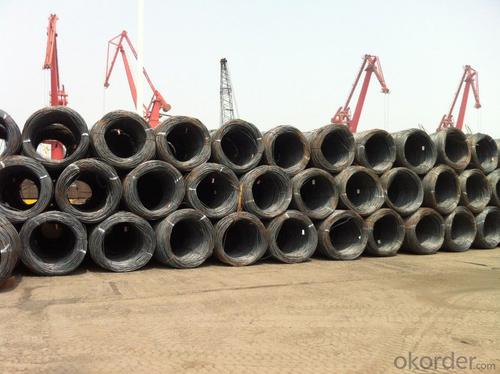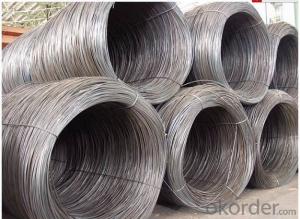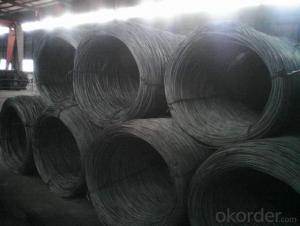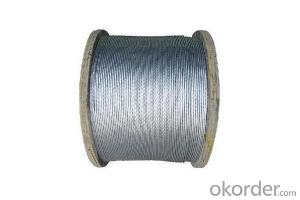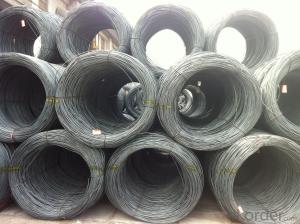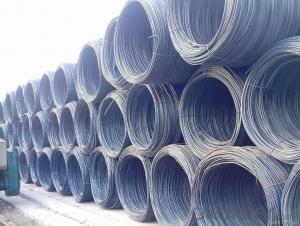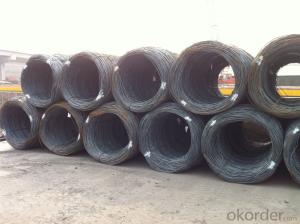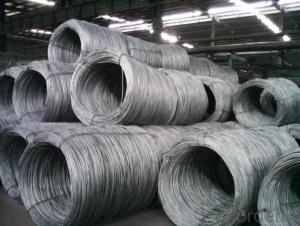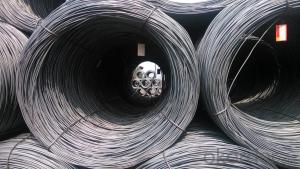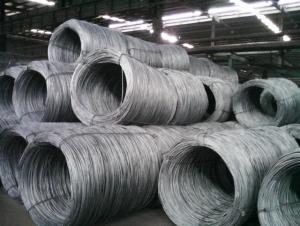Hot Rolled Wire Rods Best Quality and Price
- Loading Port:
- Tianjin
- Payment Terms:
- TT OR LC
- Min Order Qty:
- 25 m.t.
- Supply Capability:
- 20000 m.t./month
OKorder Service Pledge
OKorder Financial Service
You Might Also Like
Specification
Grade: SAE1008 Standard: ASTM
Diameter: 5.5mm, 6.5mm, 7mm, 8mm, 9mm, 10mm, 11mm, 12mm
Alloy or Not: Alloy
Technique: Hot Rolled Place of Origin: China Mainland
Chemical Composition:
Please kindly find our chemistry of our material based on SAE1008 as below for your reference:
Grade | Chemical Composition (%) | |||||
C | Mn | S | P | Si | B | |
SAE1008 | 0.10max | 0.30-0.50 | 0.050max | 0.040max | 0.30max | 0.0008min |
Mechanical properties | ||||||
Yield strength(N/mm2) | Tensile strength(N/mm2) | Elongation (%) | ||||
≥195 | 350-380 | ≥32 | ||||
Usage and Applications of Wire Rod:
After hot-rolled the products shaped into coil and delivery as finished product, including round, square,rectangular, hexagonal and so on. Since most of the products are round, it is generally called wire rod. Carbon steel wire rod is widely used in construction and manufacturing. Carbon steel wire rod is mainly used for reinforcement of reinforced concrete and welded structure or reprocessed (roberts , nail, etc.) materials, especially used to produce wire drawing, welding electrode, nails, spring, electronic, precise machinery parts and so on.
Packaging & Delivery of Wire Rod:
Packaging Detail: products are packed in coil and then shipped by container or bulk vessel
Each coil weight: About 2.05MT
Delivery Detail: within 45 days after received deposit or LC.
Label: to be specified by customer, generally, each bundle has 1-2 labels
Trade terms: FOB, CFR, CIF
FAQ:
Q1: How soon can we receive the product after purchasement?
A1: Within three days of placing an order, we will begin production. The specific shipping date is dependent upon international and government factors, but is typically one month.
Q2: How do you guarantee the quality of our products?
A2: We have established an advanced quality management system which conducts strict quality tests at every step, from raw materials to the final product. At the same time, we provide extensive follow-up service assurances as required.
Q3:What's your payment terms ?
A3:Mostly,we collect the money by T/T and LC at sight . We also accept time LC at 90/120 days sight.
Images of Wire Rod
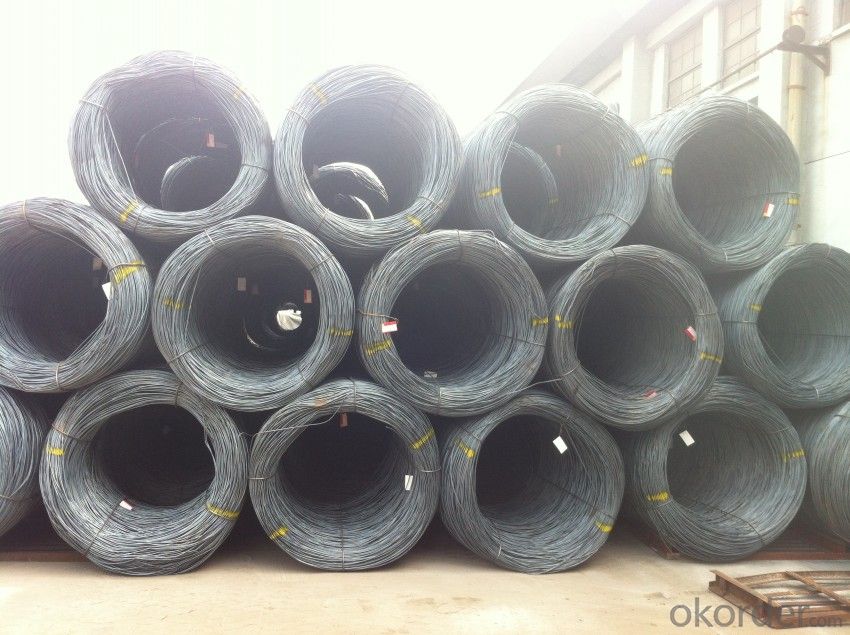
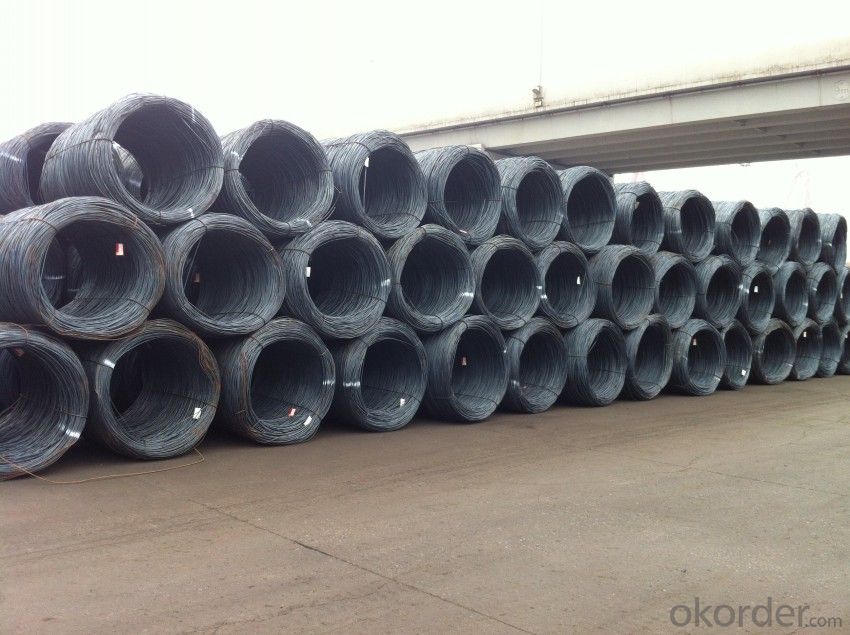
- Q: How are steel wire rods used in the production of barbed fences?
- Due to their strength and durability, steel wire rods play a crucial role in the manufacturing of barbed fences. These wire rods serve as the fundamental material for producing the barbed wire used for constructing these fences. The process begins by passing the steel wire rods through a series of dies, which reduces their diameter and increases their length. This wire drawing process ensures that the wire rods have a consistent thickness and strength. Once the desired thickness is achieved, the wire rods are twisted together to form a sturdy and resilient wire strand. This wire strand is then modified by adding sharp and pointed barbs at regular intervals. Typically, the barbs are created by cutting the wire strand and bending the cut ends outward, resulting in a hook-like structure. This design effectively deters trespassers and animals from crossing the fence. The resulting barbed wire is then wound onto rolls, making it easy to unroll and attach to fence posts or other support structures during installation. The sharp barbs on the wire act as a deterrent, making it challenging for intruders or livestock to pass through the fence without getting caught or injured. In conclusion, steel wire rods are essential for producing barbed fences due to their strength, durability, and flexibility. The addition of barbs to the wire strand further enhances the security provided by these fences, making them widely used in various applications, including agricultural fencing, military installations, and perimeter security.
- Q: How is steel wire rod used in the manufacturing of wire mesh screens?
- Steel wire rod is used in the manufacturing of wire mesh screens as it serves as the primary material for the production of the wire mesh. The steel wire rod is first drawn into the desired thickness and then woven or welded together to create a mesh pattern. This mesh is then stretched and secured onto a frame to form a sturdy and durable wire mesh screen, which can be used for a variety of applications such as filtration, separation, protection, and reinforcement.
- Q: How is steel wire rod used in the production of wire baskets and containers?
- Steel wire rod is used in the production of wire baskets and containers as it serves as the primary material for creating the wire framework. The wire rod is first processed and formed into the desired shape, such as loops or grids, to construct the structure of the basket or container. This ensures the necessary strength, durability, and flexibility required for these storage and transportation solutions. The steel wire rod also undergoes additional treatments like galvanization or coating to enhance its resistance to corrosion and increase its lifespan.
- Q: What are the different types of steel wire rod surface defect monitoring systems?
- There are various types of steel wire rod surface defect monitoring systems available in the market. Some common ones include laser scanners, optical inspection systems, electromagnetic systems, ultrasonic systems, and thermal imaging systems. These systems use different technologies to detect and monitor surface defects such as cracks, scratches, and irregularities in steel wire rods, ensuring product quality and integrity.
- Q: How are steel wire rods packaged and shipped?
- To ensure the safety and integrity of steel wire rods during transportation, a specific packaging and shipping process is followed. This process consists of several steps. Firstly, steel wire rods are typically bound together using steel straps or wires. This bundling process ensures that the rods stay aligned and tightly secured, preventing any potential movement or damage while in transit. Furthermore, it helps maintain the shape and structure of the rods. Once bundled, the steel wire rods are loaded onto pallets or wooden skids. These pallets provide a stable base and allow for easy handling with forklifts or cranes. The rods are carefully placed on the pallets, ensuring proper balance to evenly distribute the weight. After being loaded onto pallets, the steel wire rods are often wrapped with stretch film or other protective material. This wrapping not only secures the rods to the pallet but also shields them from moisture, dust, and other environmental factors during transportation. Additionally, to enhance protection, steel wire rods may be packaged in wooden crates or steel frames. These additional packaging options provide an extra layer of security, safeguarding the rods against potential damage during handling and transportation. Once properly packaged, the steel wire rods are ready for shipping. Depending on factors such as destination and volume, they can be transported via trucks, trains, ships, or airplanes. The choice of transportation method is determined by considerations such as distance, cost, and urgency. During shipping, it is crucial to handle the packaged steel wire rods with care. Appropriate equipment should be used for loading and unloading to minimize the risk of damage. Furthermore, the packages must be adequately secured within the transportation vehicle to prevent any movement or shifting during transit. In conclusion, the packaging and shipping of steel wire rods involve bundling, palletizing, wrapping with protective material, and potentially using additional packaging such as crates or frames. The packaged rods are then transported through various means, ensuring proper handling and security to maintain their quality and integrity.
- Q: What are the common applications of bright steel wire rod?
- Bright steel wire rods are commonly used in a variety of applications such as manufacturing nails, screws, wire mesh, springs, and other small metal components. They are also utilized in the construction industry for reinforcing concrete structures and in the automotive industry for making parts like cables and springs. Additionally, bright steel wire rods find application in the production of electrical wires, fencing, and various other industrial and household products.
- Q: How is steel wire rod used in the manufacturing of wire for elevator door systems?
- The manufacturing of wire for elevator door systems heavily relies on steel wire rod. For elevator doors to function properly, they need wires that are strong, durable, and capable of enduring constant use and frequent opening and closing. Steel wire rod, derived from steel billets and serving as a semi-finished product, is the primary raw material utilized in wire production. To initiate the process, steel wire rod goes through various mechanical and heat treatments to enhance its strength and flexibility. These treatments, such as hot rolling, drawing, and annealing, refine the wire's structure and enhance its mechanical properties. The objective is to ensure that the resulting wire can withstand the tensions and stresses encountered during elevator door operations. Once the wire rod has undergone processing, it is further drawn and shaped to meet the desired dimensions and specifications for elevator door systems. This involves passing the wire through a series of dies, gradually reducing its diameter and shaping it into the required form. The wire is then cut to the desired length and undergoes additional treatments, such as heat treatment or coating, to further enhance its properties and protect against corrosion. The manufactured wire is subsequently utilized in various components of elevator door systems. It is commonly employed as tension cables or counterweight cables, providing the necessary strength and support for smooth door operation. These wires are meticulously installed, routed, and connected to the elevator mechanism to ensure safe and reliable functionality. In conclusion, steel wire rod is a crucial element in the production of wire for elevator door systems. Through various treatments and processes, it acquires enhanced strength and flexibility, resulting in high-quality wire capable of meeting the demanding requirements of elevator door operations. This wire is then utilized in tension cables and counterweight cables to provide the necessary strength and support for elevator door systems.
- Q: What are the different types of steel wire rod coatings used for corrosion resistance?
- There are several different types of steel wire rod coatings that are commonly used for corrosion resistance. These coatings can provide a protective barrier that helps prevent the steel wire rod from being exposed to moisture and chemicals, which can cause corrosion. Some of the most common coatings include: 1. Zinc Coating: This is one of the most widely used coatings for steel wire rod. Zinc coating, also known as galvanization, involves applying a layer of zinc to the surface of the wire rod. The zinc acts as a sacrificial anode, meaning that it corrodes before the steel wire rod does, thereby protecting it from corrosion. 2. Epoxy Coating: Epoxy coatings are often used for steel wire rod that will be exposed to harsh environments or chemicals. These coatings provide excellent corrosion resistance and can withstand high temperatures. Epoxy coatings are typically applied through a process called electrostatic spray deposition. 3. Polymer Coating: Polymer coatings are another popular choice for corrosion resistance. These coatings are typically made from thermoplastic or thermosetting materials and can be applied by dipping, spraying, or extrusion. Polymer coatings provide a durable and flexible barrier against moisture and chemicals. 4. Ceramic Coating: Ceramic coatings are often used for steel wire rod that will be exposed to extreme temperatures or abrasive environments. These coatings provide excellent corrosion resistance, as well as high thermal and chemical stability. Ceramic coatings are typically applied through a process called thermal spraying. 5. Phosphate Coating: Phosphate coatings are commonly used as a pre-treatment for steel wire rod before applying other protective coatings. These coatings provide a thin layer of phosphate on the surface of the wire rod, which improves adhesion and corrosion resistance of subsequent coatings. Overall, the choice of steel wire rod coating depends on the specific application and the level of corrosion resistance required. Each type of coating offers unique benefits and can be tailored to meet the specific needs of the wire rod.
- Q: How is steel wire rod used in the production of wire for brush bristles?
- The production of wire for brush bristles relies heavily on steel wire rod. This rod, selected for its specific properties such as strength, flexibility, and durability, undergoes a series of manufacturing steps to become the desired wire. Initially, the chosen steel wire rod is drawn through a set of dies that gradually decrease its diameter and increase its length. This wire drawing process is repeated multiple times until the wire reaches the desired thickness and strength. Following wire drawing, the wire undergoes further processing to enhance its properties. This may involve heat treatment to improve strength and flexibility, as well as surface treatments like galvanization or coating to provide corrosion resistance. Once these treatments are complete, the wire is cut into lengths suitable for brush bristles. At this point, the wire can be further manipulated to develop specific brush bristle characteristics. For example, it may be twisted or crimped to enhance its cleaning or brushing capabilities. Lastly, the wire is attached to the brush base or handle to finalize the production of brush bristles. This is typically achieved using specialized machinery or techniques such as stapling or binding. In conclusion, steel wire rod is vital in the production of wire for brush bristles. It serves as the fundamental material that undergoes various manufacturing processes, including wire drawing, heat treatment, and surface treatments, to transform it into the necessary wire for brush bristles.
- Q: What are the main factors influencing the choice of steel wire rod order return policy?
- The main factors influencing the choice of steel wire rod order return policy are the quality of the product, customer satisfaction, and market competition. Firstly, the quality of the steel wire rod plays a crucial role in determining the return policy. If the product is consistently of high quality and meets the customer's expectations, the need for returns will be minimal. In such cases, a more stringent return policy can be implemented, ensuring that only genuine defects or issues are eligible for returns. On the other hand, if the product quality is inconsistent or below standard, a more lenient return policy may be required to accommodate customer dissatisfaction and maintain good customer relations. Customer satisfaction is another important factor. A customer-centric approach should be taken into consideration while devising a return policy. By providing a flexible and hassle-free return policy, customers will feel more confident in their purchasing decisions, knowing they have the option to return the product if they are not satisfied. This can help build trust and loyalty, leading to repeat purchases and positive word-of-mouth recommendations. Additionally, market competition plays a significant role in determining the return policy. In a highly competitive market, where customers have numerous options to choose from, a lenient return policy can act as a differentiating factor. By offering a more favorable return policy compared to competitors, a company can attract more customers and gain a competitive edge. However, this needs to be balanced with the company's profitability and operational feasibility, as overly generous return policies can impact the bottom line. In conclusion, the main factors influencing the choice of steel wire rod order return policy are the quality of the product, customer satisfaction, and market competition. A well-planned return policy that considers these factors can help ensure customer loyalty, maintain a positive brand image, and stay competitive in the market.
Send your message to us
Hot Rolled Wire Rods Best Quality and Price
- Loading Port:
- Tianjin
- Payment Terms:
- TT OR LC
- Min Order Qty:
- 25 m.t.
- Supply Capability:
- 20000 m.t./month
OKorder Service Pledge
OKorder Financial Service
Similar products
Hot products
Hot Searches
Related keywords
